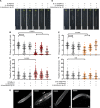Rhizobacteria Mediate the Phytotoxicity of a Range of Biorefinery-Relevant Compounds
- PMID: 31107972
- PMCID: PMC6711798
- DOI: 10.1002/etc.4501
Rhizobacteria Mediate the Phytotoxicity of a Range of Biorefinery-Relevant Compounds
Abstract
Advances in engineering biology have expanded the list of renewable compounds that can be produced at scale via biological routes from plant biomass. In most cases, these chemical products have not been evaluated for effects on biological systems, defined in the present study as bioactivity, that may be relevant to their manufacture. For sustainable chemical and fuel production, the industry needs to transition from fossil to renewable carbon sources, resulting in unprecedented expansion in the production and environmental distribution of chemicals used in biomanufacturing. Further, although some chemicals have been assessed for mammalian toxicity, environmental and agricultural hazards are largely unknown. We assessed 6 compounds that are representative of the emerging biofuel and bioproduct manufacturing process for their effect on model plants (Arabidopsis thaliana, Sorghum bicolor) and show that several alter plant seedling physiology at submillimolar concentrations. However, these responses change in the presence of individual bacterial species from the A. thaliana root microbiome. We identified 2 individual microbes that change the effect of chemical treatment on root architecture and a pooled microbial community with different effects relative to its constituents individually. The present study indicates that screening industrial chemicals for bioactivity on model organisms in the presence of their microbiomes is important for biologically and ecologically relevant risk analyses. Environ Toxicol Chem 2019;38:1911-1922. © 2019 The Authors. Environmental Toxicology and Chemistry published by Wiley Periodicals, Inc. on behalf of SETAC.
Keywords: Biofuels; Ionic liquids; Microbiome; Plants; Toxicology screening.
© 2019 The Authors. Environmental Toxicology and Chemistry published by Wiley Periodicals, Inc. on behalf of SETAC.
Figures






References
-
- Aloni R, Langhans M, Aloni E, Ullrich CI. 2004. Role of cytokinin in the regulation of root gravitropism. Planta 220:177–182. - PubMed
-
- Campos B, Colbourne JK, Brown JB, Viant MR, Biales AD, Gallagher K, Henry TR, Sappington KG, Marshall S, Whale G. 2018. How omics technologies can enhance chemical safety regulation: Perspectives from academia, government, and industry. Environ Toxicol Chem 37:1252–1259. - PubMed
-
- Cartieaux F, Thibaud M‐C, Zimmerli L, Lessard P, Sarrobert C, David P, Gerbaud A, Robaglia C, Somerville S, Nussaume L. 2003. Transcriptome analysis of Arabidopsis colonized by a plant‐growth promoting rhizobacterium reveals a general effect on disease resistance. Plant Journal 36:177–188. - PubMed
Publication types
MeSH terms
Substances
Grants and funding
LinkOut - more resources
Full Text Sources

